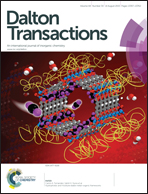Hybrid organic–inorganic chlorozincate and a molecular zinc complex involving the in situ formed imidazo[1,5-a]pyridinium cation: serendipitous oxidative cyclization, structures and photophysical properties†
Abstract
Two novel compounds, the organic–inorganic hybrid [L]2[ZnCl4] (1) and the coordination complex LZnCl3 (2), where L is the 2-methyl-3-(pyridin-2-yl)imidazo[1,5-a]pyridinium cation, were prepared using the oxidative condensation–cyclization of 2-pyridinecarbaldehyde and CH3NH2·HCl in methanol in the presence of Zn2+ cations. The metal-free interaction of the organic components afforded the salt [L][Cl]·1.5H2O (3). The use of methylamine hydrochloride instead of its aqueous solution is believed to be responsible for the cyclocondensation with the formation of L instead of the expected Schiff base ligand. Compounds 1–3 have been obtained as single crystals and characterized by elemental analysis, IR, NMR spectroscopy, and single-crystal X-ray diffraction techniques. The structure of 1 is described as layers of cations and anions stacked along the c-axis, with the minimum Zn⋯Zn distance being 8.435 Å inside a layer. In the crystal lattice of 3, the cations are arranged in stacks propagating along the a-axis; the 1D H-bonding polymer built of chloride ions and water molecules runs parallel to a column of stacked cations. The organic cations in salts 1 and 3 show various patterns of π–π stacking. The discrete molecular structure of 2 shows coordination of a Zn atom to the Npyridyl atom, which enables one of the chloride atoms attached to the metal centre to interact with a π-system of the positively charged imidazolium ring. Numerous C–H⋯Cl contacts in 1–3 are seen as space-filling van der Waals interactions of minor importance in determining crystal packing. The 1H NMR studies suggest that the Zn–N coordination found in the solid-state structure of 2 is not retained in dmso, and 1, 2 and 3 are completely dissociated in solution. The emission spectra of 1 and 2 (λmax = 455 and 445 nm, respectively) exhibit red-shifts of fluorescence wavelength when compared to 3 and differ in the shapes and maxima of the emission as well as in relative fluorescence intensity.
![Graphical abstract: Hybrid organic–inorganic chlorozincate and a molecular zinc complex involving the in situ formed imidazo[1,5-a]pyridinium cation: serendipitous oxidative cyclization, structures and photophysical properties](/en/Image/Get?imageInfo.ImageType=GA&imageInfo.ImageIdentifier.ManuscriptID=C5DT01491C&imageInfo.ImageIdentifier.Year=2015)

 Please wait while we load your content...
Please wait while we load your content...